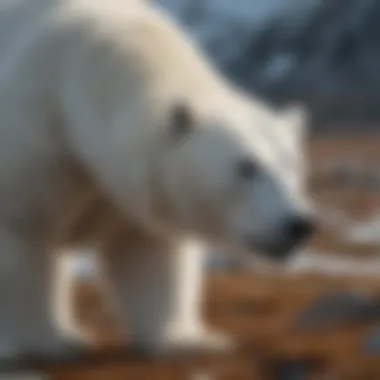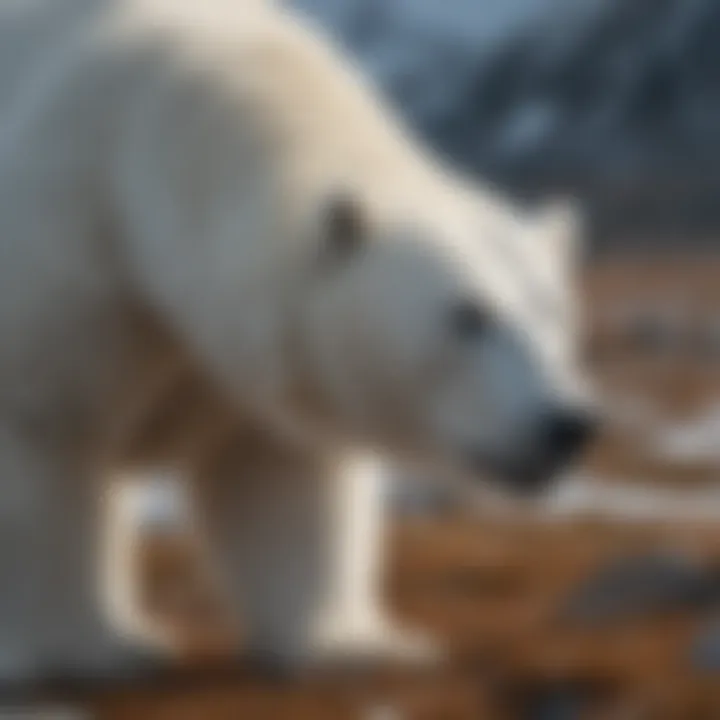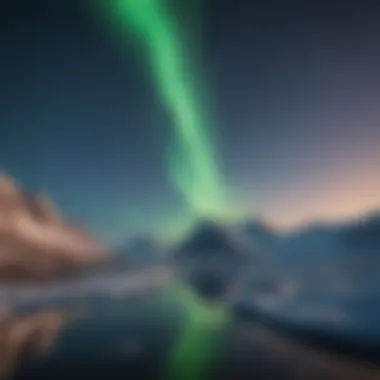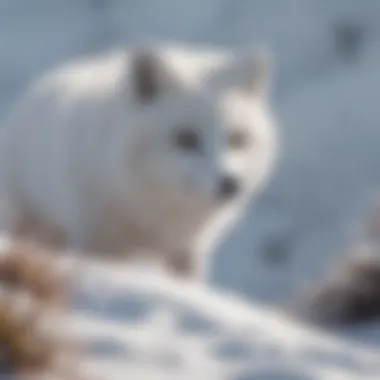Unveiling the Enigmatic Charms of the Arctic: A Deep Dive into its Unique Wonders and Phenomena


Nature Topic Overview
The Arctic, a remote and fascinating region located at the northernmost part of the Earth, is a place of extremes. From bone-chilling temperatures that plunge far below zero to majestic icebergs glistening under the midnight sun, the Arctic captivates with its untouched beauty and unique wilderness.
Fun Facts and Trivia
Exploring the Arctic unveils a treasure trove of captivating trivia for young minds. Did you know that the Arctic is home to polar bears, the largest land carnivores on the planet? These magnificent creatures roam the icy terrain in search of seals as their primary food source. Moreover, the Northern Lights, a mesmerizing natural light display in the sky, paint the night in vibrant hues, enchanting all who gaze upon them. Incorporating visuals and interactive elements into learning about the Arctic can deepen children's understanding and appreciation of this remarkable region.
Wildlife Explorations
The Arctic's diverse ecosystem teems with an array of remarkable wildlife. From fluffy Arctic foxes to graceful narwhals with their iconic spiral tusks, each species has adapted uniquely to survive in this harsh environment. Moreover, the sturdy Arctic willow and vibrant Arctic poppy are among the resilient plant life that thrives amidst the frozen landscape. Interactive features like quizzes and puzzles can engage young explorers in discovering the wonders of Arctic wildlife up close.
Environmental Awareness
Conservation and sustainability are crucial for the fragile Arctic ecosystem. Teaching children the importance of preserving this pristine environment can instill a lifelong commitment to environmental stewardship. Simple tips such as reducing plastic usage and recycling initiatives empower kids to contribute positively to nature conservation. By fostering environmental awareness, we pave the way for a brighter, more sustainable future for the Arctic and its inhabitants.
DIY Nature Activities
Engaging in do-it-yourself nature activities can enrich a child's connection with the Arctic. From crafting snowflake ornaments using recycled materials to embarking on guided outdoor expeditions to observe Arctic wildlife in its natural habitat, hands-on experiences offer valuable insights into the wonders of nature. Step-by-step guides for creating winter-themed crafts or conducting science experiments enhance children's creativity and curiosity while encouraging them to apply their knowledge practically.
Introduction to the Arctic
The Introduction to the Arctic acts as a crucial entry point into understanding the essence of this remarkable polar region. It serves as a gateway to a world filled with unique wonders and phenomena that distinguish the Arctic from any other place on Earth. In this article, the focus is on shedding light on the geographical, climatic, wildlife, cultural, environmental, and scientific aspects of the Arctic, offering a comprehensive outlook on this remote and intriguing location.
Geographical Overview
Location and Boundaries
Delving into the geographical intricacies of the Arctic, the Location and Boundaries play a fundamental role in defining the spatial extent of this region. The Arctic is centered around the North Pole, extending towards the Arctic Circle and encompassing parts of various countries like Canada, Russia, the United States, Norway, and Greenland. The unique feature of the Arctic's location is its extreme northern position, characterized by vast icy landscapes, frozen seas, and remote wilderness. This positioning contributes significantly to the Arctic's distinct climate, wildlife habitats, and the challenges posed by its harsh environment, making it a prime subject for detailed exploration and study in this article.
Arctic Circle
The Arctic Circle marks the boundary of the Arctic region, establishing the area where during the summer solstice, the sun remains visible for a full 24 hours. This phenomena, known as the Midnight Sun, is a unique feature of the Arctic Circle and contributes to the extreme variations in daylight patterns experienced in this part of the world. The Arctic Circle, with its symbolic significance and defining role in delineating the Arctic realm, serves as a key focal point in discussions related to the Arctic's geography and celestial occurrences, adding depth and intrigue to the exploration presented in this article.
Land and Water Distribution
A critical aspect of the Arctic's geography is its distribution of land and water, characterized by vast expanses of ice-covered oceans, glaciers, and sparse vegetation. The landmass in the Arctic primarily consists of islands and the northernmost portions of various continents, while the surrounding waters include the Arctic Ocean and its peripheral seas. The unique balance between land and water in the Arctic region influences its climate, ecological systems, and human activities. Understanding the distribution of land and water in the Arctic provides valuable insights into the environmental dynamics, species habitats, and the interconnectedness of ecosystems, essential components highlighted in the exploration of Arctic facts within this article.
Climate and Weather Patterns


Extreme Cold
Among the most defining features of the Arctic's climate is the extreme cold that prevails throughout much of the year. The temperatures in the Arctic can plummet to staggering lows, creating an environment that is challenging for human habitation yet uniquely suited for specialized wildlife and plant species. The extreme cold of the Arctic climate shapes the landscapes, influences ecosystem dynamics, and poses significant challenges for any human activity in the region. Exploring the intricacies of extreme cold in the Arctic offers a glimpse into the resilience of life in the face of formidable environmental conditions, a theme that resonates with the essence of this article.
Midnight Sun
The Midnight Sun phenomenon in the Arctic refers to the exceptional occurrence where the sun remains visible at midnight, providing continuous daylight for a specific period. This natural spectacle, tied to the axial tilt of the Earth and the Arctic's location relative to the sun, is a captivating feature of Arctic summers. The Midnight Sun influences various aspects of life in the Arctic, from wildlife behavior to cultural traditions, and plays a significant role in shaping human experiences and perceptions of time and space in this polar environment. Exploring the Midnight Sun enriches the understanding of the Arctic's unique climate and celestial interactions, offering a compelling narrative that resonates with the intrigue of this article.
Polar Nights
Conversely, the Polar Nights in the Arctic represent an extraordinary natural phenomenon characterized by extended periods of darkness during the winter months. The absence of sunlight for weeks or months poses distinct challenges and opportunities for the Arctic's inhabitants and ecosystems, shaping behaviors, adaptations, and cultural practices. Polar Nights influence the rhythm of life in the Arctic, affecting everything from wildlife migrations to human routines, highlighting the profound impact of light availability on various aspects of Arctic existence. Examining the Polar Nights allows for a deeper appreciation of the Arctic's seasonal dynamics and the adaptations required to thrive in this extreme environment, a theme central to the narrative of this article.
Arctic Wildlife
Unique Animal Species
Polar Bears
Polar bears are iconic creatures of the Arctic known for their adaptation to extreme cold environments. Their thick fur and layer of fat insulate them from the freezing temperatures prevalent in the region. These majestic animals are of crucial significance in the Arctic ecosystem, playing a vital role in maintaining balance as top predators. The Polar Bear's unique features, such as their unparalleled swimming abilities and incredible sense of smell, make them well-suited for survival in the harsh Arctic conditions.
Arctic Foxes
Arctic foxes, with their fluffy white coat and bushy tails, are highly adapted to the cold Arctic climate. Their ability to thrive in snowy surroundings and change fur color with the seasons showcases their remarkable resilience. These cunning hunters play a crucial role in the Arctic food chain, preying on small mammals and scavenging for food. Despite their predatory nature, Arctic foxes have a certain charm that captivates observers and researchers alike.
Beluga Whales
Beluga whales, also known as 'sea canaries' for their melodious vocalizations, are enchanting marine mammals of the Arctic. Their unique white coloration and flexible necks set them apart from other whale species. Belugas' social behaviors, including their close-knit family groups and communication through chirps and clicks, make them a fascinating subject for study in the Arctic. These gentle giants' presence resonates throughout the frigid waters, adding to the appeal and diversity of Arctic wildlife.
Migration Patterns
Bird Migration
The Arctic hosts various bird species that migrate to the region during breeding seasons, taking advantage of the extended daylight hours and abundant food sources. These migratory birds play a vital role in the ecosystem by dispersing seeds, controlling insect populations, and adding to the overall biodiversity of the Arctic landscape. Their annual journeys reflect the interconnectedness of habitats across continents and the resilience of avian species in adapting to challenging environments.
Marine Mammal Migration
Marine mammals, such as whales and seals, undertake remarkable migratory journeys to the Arctic, following food sources and breeding grounds. These migrations span vast distances, highlighting the animals' endurance and navigational skills. The influx of marine mammals into Arctic waters not only enriches the region's marine diversity but also underscores the significance of the Arctic as a global hotspot for wildlife observation and research.
Seasonal Behaviors


Arctic wildlife exhibits distinct behaviors that align with the changing seasons, from mating rituals to hibernation strategies. These seasonal adaptations reflect the animals' reliance on environmental cues for survival and reproduction. Understanding Arctic wildlife's seasonal behaviors provides valuable insights into their life cycles, population dynamics, and resilience in the face of environmental fluctuations.
Cultural Aspects of the Arctic
As we delve into the intricate tapestry of the Arctic, one cannot overlook the profound significance of its cultural aspects. The indigenous communities of the Arctic hold valuable knowledge and traditions that are integral to understanding this unique region. From the intricate art forms to the rich tapestry of folklore, the Cultural Aspects of the Arctic offer a glimpse into the deep connection between the people and the land they call home.
Indigenous Communities
Inuit Culture
The Inuit Culture embodies a profound connection to the Arctic environment. The resilience and adaptability of the Inuit people have shaped their culture over centuries, emphasizing communal living and sustainable practices. The intricate knowledge of the Arctic's ecosystem embedded within Inuit Culture provides invaluable insights into navigating the harsh Arctic terrain and fostering harmonious relationships with nature. This deep-rooted bond with the environment makes Inuit Culture a beacon of sustainability and cultural heritage in the Arctic.
Sami People
The Sami People bring a vibrant tapestry of traditions and practices to the Arctic landscape. Their nomadic lifestyle, herding reindeer across vast snowy expanses, reflects a harmonious relationship with the natural world. The distinctive joik singing style of the Sami people encapsulates tales of nature and life in the Arctic, preserving their cultural identity through melodious expression. This unique cultural heritage adds a kaleidoscopic dimension to the Arctic's cultural tapestry, enriching the region with diverse traditions.
Traditional Practices
The embrace of Traditional Practices in the Arctic underscores the timeless wisdom passed down through generations. From the crafting of intricate handicrafts to the observance of seasonal ceremonies, traditional practices reflect the deep-rooted values and beliefs of Arctic communities. These practices serve as a link to the past, ensuring continuity and preservation of cultural heritage amidst the winds of change. The resilience and adaptability embedded in traditional practices are essential pillars that sustain the cultural identity of Arctic communities, fostering a sense of belonging and continuity.
Art and Music
Immersing ourselves in the artistic expressions of the Arctic unveils a myriad of stories and inspirations that encapsulate the essence of this captivating region. The enchanting glow of the Northern Lights has served as a muse for artists and storytellers throughout history, igniting imaginations and evoking a sense of wonder. Drums and chants resonate with the rhythms of Arctic life, embodying the spirit of community and togetherness. Folklore and Stories handed down through generations weave a rich tapestry of cultural heritage, conveying morals, values, and ancestral wisdom. The Art and Music of the Arctic breathe life into cultural narratives, offering a window into the soul of this enigmatic region.
Environmental Challenges
As we embark on the journey to explore the Arctic, it is imperative to delve into the pressing Environmental Challenges that threaten this unique region. The fragile Arctic ecosystem is in peril due to various factors, including climate change and human activities. Understanding these challenges is crucial in safeguarding the Arctic's biodiversity and delicate balance. By highlighting the significance of Environmental Challenges, we shed light on the importance of conservation and sustainable practices in ensuring the preservation of this pristine environment.
Climate Change Impact
Melting Ice Caps
The phenomenon of Melting Ice Caps stands as a critical issue plaguing the Arctic, with far-reaching implications for global climate systems. The accelerated retreat of ice caps not only contributes to rising sea levels but also disrupts wildlife habitats and accelerates climate change. The relentless thawing of these icy giants unveils stark evidence of environmental degradation, necessitating immediate attention and action. Understanding the gravity of Melting Ice Caps underscores the urgency of implementing strategies to mitigate their impacts and preserve the Arctic's natural beauty.
Loss of Habitat
The Loss of Habitat poses a severe threat to Arctic wildlife, pushing numerous species to the brink of extinction. As critical ecosystems diminish due to human encroachment and environmental changes, iconic creatures like polar bears and arctic foxes face unprecedented challenges in finding suitable habitats for survival. The ramifications of habitat loss reverberate across the food chain, impacting entire ecosystems and highlighting the interconnectedness of Arctic biodiversity. Addressing this issue requires collaborative conservation efforts and sustainable practices to protect vital habitats and safeguard vulnerable species.
Threatened Species


The concept of Threatened Species encapsulates the harrowing reality faced by many Arctic animals on the brink of extinction. From majestic beluga whales to elusive arctic seabirds, diverse species face increasing threats due to habitat loss, climate change, and human activities. The declining population trends signify a troubling trend that underscores the urgent need for conservation measures and concerted action. By prioritizing the protection of threatened species, we honor the intrinsic value of Arctic wildlife and work towards preserving the rich tapestry of life in this remote region.
Pollution Concerns
Plastic Pollution
The pervasive issue of Plastic Pollution poses a significant challenge to the Arctic environment, with plastic debris contaminating pristine landscapes and harming marine life. From microplastics in sea ice to littered shorelines, the detrimental impacts of plastic pollution are far-reaching and long-lasting. Addressing this menace requires a multifaceted approach, including reducing plastic consumption, promoting recycling, and supporting cleanup initiatives. By raising awareness about the dangers of plastic pollution, we strive to foster a culture of environmental stewardship and responsible waste management.
Oil Spills
The specter of Oil Spills looms large over the Arctic, endangering marine habitats, wildlife, and communities dependent on pristine waters for survival. The catastrophic consequences of oil spills reverberate for years, devastating ecosystems and jeopardizing fragile biodiversity. Mitigating the risks of oil spills demands stringent regulations, emergency response preparedness, and sustainable energy practices to prevent future environmental disasters. By emphasizing the value of marine protection and proactive measures, we aim to avert potential ecological catastrophes and promote responsible resource management.
Environmental Conservation Efforts
Efforts towards Environmental Conservation play a pivotal role in safeguarding the Arctic's delicate ecosystem and mitigating the impacts of human activities. Conservation initiatives encompass a wide array of strategies, including protected areas, sustainable resource management, and community engagement. By championing conservation efforts, we uphold the principles of environmental sustainability and lay the groundwork for a resilient Arctic future. Encouraging stewardship and responsible conservation practices fosters a sense of responsibility towards nature and ensures the longevity of the Arctic's unique ecological heritage.
Scientific Research in the Arctic
Scientific research in the Arctic plays a pivotal role in understanding the complex dynamics of this unique polar region. Through meticulous investigation and analysis, scientists delve into various aspects like climate change, biodiversity, and oceanography. By studying the Arctic, researchers gain valuable insights into global climate trends and potential ramifications for ecosystems worldwide. The significance of scientific research in the Arctic cannot be overstated, as it contributes vital data for informed decision-making and environmental conservation efforts.
Exploration and Discoveries
Research Stations
Research stations in the Arctic serve as crucial hubs for scientists conducting fieldwork and experiments in extreme conditions. These stations provide essential resources and accommodations for researchers, enabling them to study the region's diverse ecosystems and wildlife up close. The uninterrupted access to the Arctic environment allows for continuous data collection and long-term observations, enhancing our understanding of this remote and sensitive ecosystem.
Study of Arctic Ecosystems
The study of Arctic ecosystems focuses on the intricate relationships between organisms, ice formations, and the surrounding environment. Researchers investigate the effects of climate change on wildlife habitats and food chains, identifying critical trends and potential ecological disruptions. By examining species interactions and environmental factors, scientists can predict future changes and inform conservation strategies to protect Arctic biodiversity.
Climate Studies
Climate studies in the Arctic concentrate on monitoring temperature variations, sea ice extent, and atmospheric conditions. These studies help to track the impact of global warming on the Arctic region, highlighting unprecedented shifts in climate patterns and their consequences. By analyzing climate data, researchers can forecast environmental changes and contribute essential data to climate models and projections.
Importance of Arctic Studies
Global Climate Impact
The global climate impact of Arctic studies underscores the interconnected nature of climate systems worldwide. Changes in the Arctic reverberate across the globe, influencing weather patterns, sea levels, and ecosystem dynamics. Understanding the Arctic's role in regulating the Earth's climate is paramount for predicting future trends and implementing effective mitigation strategies to address climate change.
Biodiversity Insights
Biodiversity insights from Arctic studies reveal the rich array of species inhabiting this remote region and their adaptations to extreme conditions. Examining Arctic flora and fauna sheds light on evolutionary processes, species distributions, and conservation priorities. By studying biodiversity, scientists uncover valuable information crucial for safeguarding fragile Arctic ecosystems.
Oceanography and Sea Ice Studies
Oceanography and sea ice studies in the Arctic focus on the dynamics of ocean currents, sea ice movement, and marine ecosystems. Researchers analyze the impact of melting sea ice on ocean circulation, marine life, and nutrient cycles. By investigating oceanographic processes, scientists gain valuable insights into climate feedback mechanisms and the role of the Arctic Ocean in global ocean circulation.







